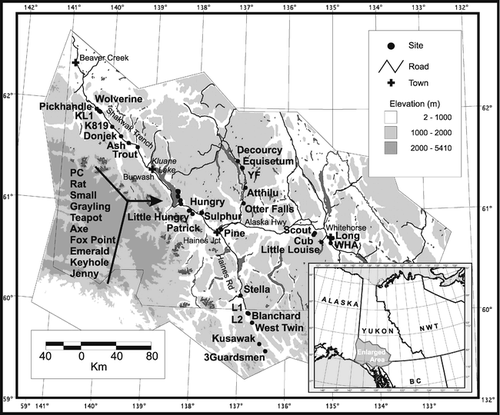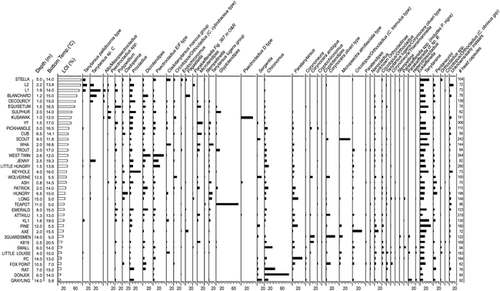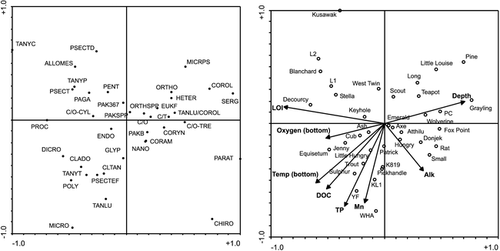Figures & data
FIGURE 1. Map of study site in southwest Yukon and northern British Columbia showing location of study lakes

FIGURE 2. Chironomid assemblages from lakes in southwest Yukon and northern British Columbia arranged by weight-loss-on-ignition (%LOI) values. Weight-loss-on-ignition, bottom water temperature, lake depth, and number of head capsules shown for these sites. Three Guardsmen Lake is included to show chironomid fauna even though it was eliminated from the ordinations

FIGURE 3. Redundancy analysis (RDA) covariance biplots showing the relationship between the 8 measured environmental variables with a statistically significant relationship to chironomid distributions and the 37 lakes (A) and the 38 chironomid taxa (B). Abbreviations for the chironomid taxa are: CHIRO—Chironomus; CLADO—Cladopelma; CLTAN—Cladotanytarsus mancus group; CORAM—Corynocera ambigua; COROL—Corynocera oliveri type, CORYN—Corynoneura; C/T—Corynoneura/Thienemanniella; C/O–CYL—Cricotopus/Orthocladius (C. cylindraceus type); C/O–TRE—Cricotopus/Orthocladius (C. tremulus type); C/O—Cricotopus/Orthocladius; DICRO—Dicrotendipes; ENDO—Endochironomus; EUKF—Eukiefferiella; GLYP—Glyptotendipes; HETER—Heterotrissocladius; MICRPS—Micropsectra atrofasciata type; MICRO—Microtendipes; NANO—Nanocladius; ORTHO—unknown Orthocladiinae; ORTHSPP—Orthocladius spp.; PAGA—Pagastiella; PAKB—Parakiefferiella cf. sp. B (CitationWalker, 1988); PAK367—Parakiefferiella Fig. 367 in Oliver and Roussel; PAKSPP—Parakiefferiella spp. (including P. nigra); PARAT—Paratanytarsus; PENT—Pentaneurini; POLY—Polypedilum; PROC—Procladius; PSECTEF—Psectrocladius E/F type (Fig. 9.61 E/F in Wiederholm); PSECTD—Psectrocladius D type (Fig. 9.61 D in Wiederholm); ALLOMES—Allo/Mesopsectrocladius; PSECT—Psectrocladius spp.; SERG—Sergentia; TANYT—Tanytarsina; TANYC—Tanytarsus sp. C; TANLU—Tanytarsus lugens group; TANLU/COROL—Tanytarsus lugens/Corynocera oliveri type; TANYP—Tanytarsus pallidicornis type

TABLE 1 Water chemistry and physical variables from 39 lakes in southwest Yukon and northern British Columbia. Alkalinity (Alk) was measured as mg/L CaCO3, and conductivity was corrected to 25°C. Lake area was calculated manually from 1:50,000 maps (Energy, Mines and Resources, Canada). “NA” indicates data were not available and, therefore, mean values for that variable were substituted. The variables total phosphours (TP), filtered phosphorus (TP-F), Al, and Mo had detection limit values substituted in some cases (see explanation in text). These were 4 μg/L, 4 μg/L, 0.001 mg/L, and 0.0005 mg/L, respectively. In the case of bottom oxygen for Patrick Lake and K819, these values were assumed to be the same as surface oxygen because both lakes were less than 2 m deep. Elev. = elevation, T = surface water temperature, Tb = bottom water temperature, DOs = surface oxygen, DOb = bottom oxygen, Cond = conductivity, Alk = alkalinity, DOC = dissolved organic carbon, TKN = total Kjeldahl nitrogen, Chla = chlorophyll a, LOI = loss-on-ignition
TABLE 1 (Ext)
TABLE 2 Canonical coefficients, t values, and intra-set correlations for the subset of eight environmental variables for redundancy analysis axes 1 and 2. DOC = dissolved organic carbon, TP = total phosphorus, LOI = loss-on-ignition
TABLE 3 The ratio of the first constrained eigenvalue to the second unconstrained eigenvalue, percentage variance explained by the environmental variables, and results of the Monte Carlo Permutation tests (500 unrestricted permutations) in a constrained redundancy analysis where each variable is used as the sole constraining variable at a time. DOC = dissolved organic carbon, TP = total phosphorus TKN = total Kjeldahl nitrogen, Chla = chlorophyll a, LOI = loss-on-ignition
TABLE 4 Summary of partial redundancy analysis of modern chironomid assemblages in the 37 lakes. P = significance level of Monte Carlo permutation test (500 unrestricted permutations). LOI = loss-on-ignition, Tbot = bottom temperature